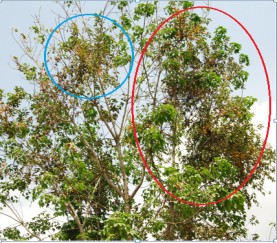Hybrid compounds offer attractive opportunities
to combine useful properties of both organic and inorganic simples within a
single molecular scale composite. On the one hand, these salts offer, scientifically
and technologically significant chances in different areas of catalysis,
optical properties, biology, magnetic functional materials. On the other hand,they may contribute to higher electrical mobility (as a result of the strongcovalent bonding within these systems). Halogenometalate hybrid compounds based
on elements of transition (II) ions prove to have a significant weight to
fabricate low-cost electronic devices (as Thin Film Transistor or Organice-
Inorganic Emitting Diode).

Among the most frequently used of polydentate
ligands which have the ability with bond to several metal centers, dipicolinic
acid (C7H5NO4, 2,6-pyridinedicarboxylic acid) is a well-known that occurs in
many natural compounds exhibiting various biological functions and potential
pharmacological activities. 2,6-pyridinedicarboxylic The ligand containing N
and O polydentate donors, which pave the way provide great advantages for
assembling compounds with new structures. The dipicolinic acid ‘dpc’ ligandwith Zn (II) ions has commonly 1 or 2 coordination modes. In one coordination
mode, a single planar dpc ligand associates in the equatorial plane of a Zn
(II) cation with other ligands such as H2O or pyridine-based heterocycles,
which occupy the remaining sites. This leads to the formation of square
pyramidal or octahedral coordination geometry or two perpendicularly
coordinated planar dipicolinic molecules generating distorted octahedral
coordination geometry.
Electronics
based on π-conjugated organic polymers and molecules have been extensively
explored during the last years. The significant interest in the development of
organic electronics results in part from the fact that this technology offers
new or improved electroactive and opto-electronic features as compared to the
inorganic counterparts. The organic electronic materials may be flexible andcan be also fabricated using printing devices. Other characteristics that make
organic electronic materials promising as the active material in bioelectronics
include:

Functionality
which can easily be defined at the materials level, giving that chemical
biosignals can be translated into electronics signatures or signals within the
material itself.In the thin-layer state organic electronic materials are often
transparent, which permits optical transmission imaging and use of various
microscopy-based techniques when analyzing biological specimens interacting
with the tool.Organic electronic materials are soft and can be (self-)organized to mimic biological structures.Organic conjugated materials conduct
electrons as well as ions.Organic conjugated materials can be equipped with
(bio-) molecular side-groups to promote cell viability.
Compounds having imine or azomethine (–C=N–) functional
group are known as Schiff bases. They were first reported in 1864 by German
Chemist, Hugo Schiff and hence they are named so. For the synthesis of Schiffbase, a number of methods have been described in literature. These are now
synthesized by a simple one pot condensation of an various amines/hydrazides
with carbonyl compounds, water is eliminated during condensation process.Schiff
bases are synthesis from simple reaction between acetone and primary amine.
Water is byproduct in this reaction.Other name for Schiff bases are imine or
azomethine.
Medicinal plant is defined as any plant with one or more
of its organs containing substance that can be used for therapeutic purpose or
which can be used as precursors for the synthesis of antimicrobial drugs.
Plants are presently the sources of medicines for many people of different agein many country of the world, where diseases are treated primarily with
traditional medicines obtained from plants. The modern pharmaceutical industry
itself still relies largely on the diversity of secondary metabolites in plants
and secondary metabolites of which at least 12,000 have been isolated; a number
estimated to be less than 10% of the total. In plants, the synthesized aromatic
substances (metabolites) are used as defensive weapons against predation by
microorganisms, insects and herbivores.




